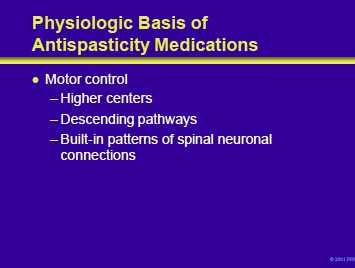Page 2 of 18

Antispasticity medications exert their effects upon motor centers including:
- Higher centers in the cortex, basal ganglia, and cerebellum. Cortical neurons whose influence may be modulated include projection neurons and interneurons. Neurons in the cortex and other motor control regions may utilize a variety of neurotransmitters including glutamate, glutamine, GABA and dopamine.
Descending pathways and nuclei that may be influenced by antispasticity medications include the following:
- Reticulospinal tract: trunk and proximal extremity control with serotonin and norepinephrine as neurotransmitters
- Pyramidal tracts: discrete distal extremity control with glutamate as a neurotransmitter
- Vestibulospinal tract: trunk and head control
- Locus ceruleus: facilitatory drive or spinal cord reflex activity; activity reduced by a2 adrenergic receptor agonists
As shown on the next slide, spinal effector mechanisms are also active.

